page 1
| Simplistic Dualities and Mathematics 1 | Simplistic Dualities and Mathematics 2 | Simplistic Dualities and Mathematics 3 | Simplistic Dualities and Mathematics 4 |
Visitors as of 2/27/2021

The title of this page is a supplement to the ideas being presented in a "Infinitesimal versus Accordion Calculus" illustration that I am at present still working on. There is a need to provide examples of dichotomous thinking in mathematics just as it is of value to place the "2" in the "1- 2- Many" phrase. The average reader may not even consider to think about the presence of, much less the quantity of two-patterned ideas being used in mathematics, whereby to suggest that much of current mathematics is based on a mimicry of reciting primitive orientations would not be understood... if at all even though such a list and explanation are provided anyway.
What I am trying to accomplish is to show that not only is there an over-riding reliance of patterns-of-two in mathematics, but provide examples of patterns-of-three as a contrast. If you are not firmly conscious of how frequent patterns-of-three crop up in different subjects in different guises, the presence of patterns-of-two may not likewise be firmly acknowledge and represent a primivity of conceptualization as does the over-riding reliance of "twos" in economics which brings humanity recurring problems. This statement needs to be restated on each of the dualities pages because they do not explicitly focus on patterns-of-two alone.
Much of Mathematical thinking is stuck in a two-patterned referencing mode, and not just merely reciting the "2" as is the need when sequencing nor the recurring "squaring" of this, that, or another. It is more than a mere sequencing of mental activity that the various dichotomies are being used. It is a stark realization as to the current state of mathematics in what I believe to be a primivity. While this page and its followers are almost wholly focused on presenting examples of the very primitive state of expression mathematics is in (albeit in an embellished form); corresponding to the primitive counting sequence of 1- 2- Many... I have provided a few examples from other perspectives in order to show that it is a phenomena not only occurring in Mathematics, but other thinking genres as well— and attests to the backwardness the human brain is regurgitating from one generation to the next due to an environmentally imposed set of limitations. It is not that humanity is incapable of moving beyond itself, it is just that the environment is forcing humanity to be a myna bird which parrots intellectual activity into a pigeon hole of activity as a survival mechanism.
The three incremental environmental deteriorations I will repeat often are:
- The Sun's energy is burning out.
- The Sun's value: The Power of the Sun
- The Earth's rotation is slowing down.
- The value of the Earth's rotation: Consequences of the Earth's Rotation
- The Moon is receding.
- The value of the Moon's presence: How does the Moon affect the Earth?
If you do not know what effects these activities have on life, it may well be difficult for you to understand what I am trying to convey. In addition, the time scale of measurements typically associated with geological stratifications is a wrong measuring stick for biological processes. At present let me suggest that the "instrumentation" of our physiology (and other life forms as well and let me add non-animate materials), is appreciably different from the instrumentation which humans devise to measure, catalogue and respond to environmental changes. Just because we devise instruments to measure or detect a given change, difference, or presence/absence and they do not show us what someone may claim as a factuality, should not lead us to automatically determine one over the other is right or wrong. We need to be more open-minded. Geologically speaking, the life-span of humans is like the life-span of Fruit (vinegar) flies to us. Hence, in this sense, we need to look upon the small (incremental) effects of the Sun, Earth and Moon not in a static infinitesimal way, but a dynamic finitesimal perspective. Using mathematics to analyze mathematics can help us appreciate the changes taking place, because the recurring patterns in mathematics, (and psychology... as well as other subjects) such as the apparent obsession with two-patterned ideas, is a tell-tale sign not only of repetition, but an impression being forced upon us by the changing environmental conditions exhibiting a course headed towards a demise.
While one can reference the idea of The Evolution of Counting: Counting Milestones through Age 3, the evolution to which I am referring has to do with the history of mathematical thinking for the whole of humanity beginning in the distant (ancient) past that was undoubtedly influenced by the most primitive forms of early commerce put into practice as a bartering system. Hence, the concept for the quantity "1" can be viewed as a cognitive milestone that at sometime later was added to by the achievement of another milestone "2", whereas in each case the 1 and 2 were interchangeably used to identify the limit or some idea of "all". Each milestone was in-turn supplanted by another term, word, and/or symbol which led eventually to a cognitive position where the notion of "1- 2- Many" was achieved in some manner, and represented a milestone of achievement. Hence, the "1- 2- Many" phrase can symbolize the idea of start and stop, dot and dash, and other dualistic organizational frames of reference such as binomial, binary, dimer, polarization, etc... The frequency of usage and the persistence of such two-patterned orientation suggests that the human brain may well be subjected to an environmentally based imposition to be stuck in such a recurring mode of thought processing.
In reading this page, I am assuming that the reader is familiar with the development of counting, herein referenced as a 1- 2- Many (triple) grouping, though in reality, each number may well have been a cognitive mile-stone before the next one was achieved and incorporated into a developing sequence. Whereas each culture, in their own language-equivalent way may have used a word and not necessarily a symbol designating the quantity "1" or "2" such as the reference of "many" being used to describe three or more items; one need not be too literal in assuming that the phrase "one- two- many" or "1- 2- Many" was the actual cross-cultural standard simply because humans share a similar type of physiology. The word "many", for instance, may have been something suggestive of "heap, much, more, a lot" or otherwise. Nonetheless, whatever word and/or symbol and/or gesture may have been used, the fact remains that there may well have been another cognitive stop before the human brain began to elucidate higher quantities with other words and symbols. The "1- 2- Many" is used as a symbolic reference to the cognitive starts and stops experienced and achieved along the way of the developmental trend of number usage. This three-pattern suffices to express a start, the gathering of a second wind, and then a step towards infinity, though there are an infinitesimal amount of symbols between the beginning and the "other end" denoted as infinity. By being able to label an end that is suggested as having no end, we therefore aptly describe a human cognitive limitation.
Let me affirm the idea that each stage of this simplistic cognitive development is not reached in most cases. Hence, a recurrence of the "two" as expressed by the many types of dichotomy one can encounter not only in mathematics but other traditions of thought processing as well such as Psychology and Philosophy. The widely used instances of singular and double-positioned symbolic/linguistic references (and assumed progression using the term "quadratics" which is a mere doubling of the "2"); and the paucity of three- or triple-focused orientations by way of the language being employed to mask the third primitive counting sequence label referred to as "many" or heap, or bunch, or polynomial or whatever one may conjecture to use as a label for "more than two" or "more than three"; need to be identified and interpreted according to their actual stage of primitive cognition where math equations themselves have taken on the role of embellishing the existence of a primitive thinking model... thereby offering some means of concealing, camouflaging, distracting, and otherwise averting the attention of humanity from recognizing that humanity is once again stuck in a primitive level of mathematical conceptualization. Far too much of mathematics is an acrobatic exercise in embellishing primitive cognitive patterns to give the impression that a higher form of thinking is taking place, but actually isn't. Mathematics is engaged by those who become adept in sleight-of-hand trickery.
As an example outside the realm of mathematics because of its wide familiarity, let me reference the concept of Yin and Yang. As a dichotomy it has been transformed into a trichotomy by adding the concept of unity, whereby we get the phrase yin- unity- yang. While some readers may prefer to use the idea of compliment, binomial, balance, or complement and contrast to maintain the usage of a dual idea or singular entity with a dual purpose/personality like the wave/particle idea of atomic entities, the two-patterned versus three-patterned representation may seem to be a negligible, if not nit-picky orientation, it nonetheless provides an inkling to understanding states of cognitive transitioning. Just like some early counters who used their language equivalent term for "2" inter-changeably with "Many" without having to resort to using a separate term which signified a third concept divorced from the 2 that was used both in a singular and polynomial context; traditional users (thinkers) of Yin/Yang might well say that each is a complement and that this notion therefore automatically signifies a third notion without having to rely on a separate entity. As if using some formula of "two-patterned" thinking is a sufficient abbreviation or short-cut for another higher cognitive activity. Hence, there will be those who say that the usage of dichotomies in mathematics is a meritable usefulness, without placing such a usage in the context of being a representative content illustrating a cognitive limitation being practiced over and over and over again.
- If we think that somewhere in human history a one-for-one correspondence took place, this only suggests that a recognition of the quantity "one" was developed conceptually, even though a stick, bone, rock or lines in the dirt amounted to more than the quantity one. It can be agreed they had a sense of the "one", or singular, which did not prevent them from associating many ones together, nor that the concept of "one" had even been linguistically developed. We simply guess that they had.
- It is not difficult to see that following the conceptualization of the "one" which may have been identified by a word (or at least some recognized gesture), items were at sometime in history conceptually paired. Hence, humanity went from a singular "one" conceptualization with an associated word (and/or gesture beyond a simple marking system), to a "one-and-two" stage of compartmentalizing. After each stage of acquired development, there was a stopping point in the cognitive development of a peoples or at least person's number sense. Hence, it would be ONE... stop, and everything beyond ONE was some sense of MANY, called a heap, a lot, much, more, etc..., corresponding to whatever word was used in a given language. Then we can image that this same sequence of events occurred at the conceptualization of "two". With every quantity beyond two now distinguished with whatever idea, notion, word and/or symbol related to much, many, more, heap, lots-of, etc...
- From the three-patterned ONE...TWO...Many sequence of counting, we find historical representations of greater quantities often involving the pairing of ideas to create a single word, though in some cases such as after the 10, the ideas of one and ten, two and ten, three and ten, etc., came into being, from which was derived the familiar "thirteen", "fourteen", "fifteen" etc,.. which identifies three-ten, four-ten, five-ten, etc...,
- The ONE... stop... TWO... stop... THREE...stop, is highly reminiscent of the pattern found in amino acid sequences where there are three stop codons and one start codon, unless we consider the binary pattern of dashes and dots in Morse Code or two rows of three (or less) dots each in Braille to be closer approximations of cognitive parallelism.
- One- Two- Many early counting sequence (that in some cases may have been one, two, three, four, many (presenting a 3 to 1 ratio)
- Three stop, One start amino acid codons (a 3 to 1 ratio)
- DNA/RNA similarities 3 amino acids are the same in DNA/ RNA (Adenosine- Cytosine- Guanine) with 1 being different: (Thymine/ Uracil)... a 3 to 1 ratio
- 3 to 1 ratio of Mendilian inheritance or its multiple of 3 to 9
- Morse code is a binary: dots and dashes (with spaces)
- Braille (for the blind) has two rows of 3 or fewer dots
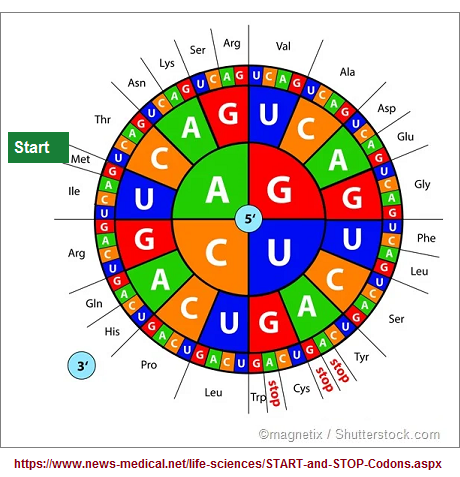 |
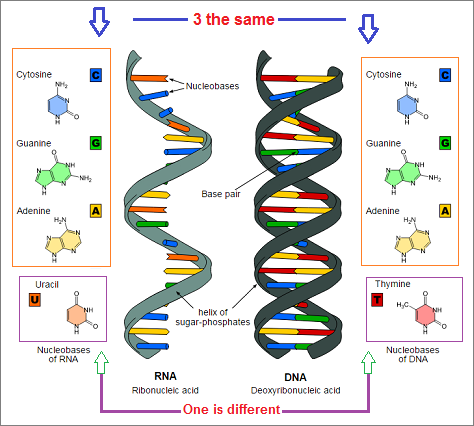 |
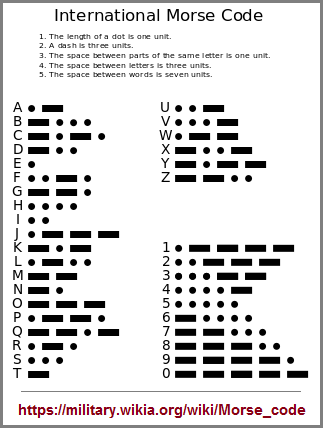 |
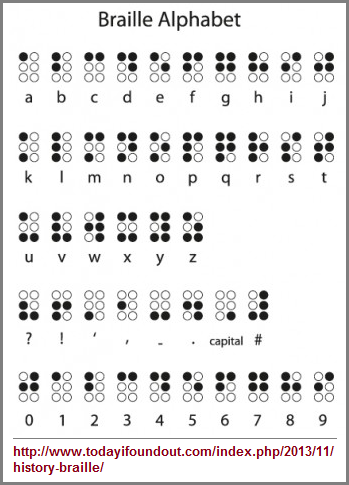 |
- Nonetheless, this "one-two-many" counting idea used as a reference by modern day peoples to illustrate the slow progression by which ancestral humanity developed and used a sense of enumeration, is being exhibited today in multiple instances; but not as many as you might think should be evident in basic math equations. We see multiple references of singularity and pairing, and a few three-part conceptualizations, but no greater enumeration beyond this. True, equations can deal with large quantities, but these expressions give the impression of being used as was the concept of "Many" by primitive peoples. Thus, modern day mathematics gives the impression of being stuck in an ancient mode of conceptualization, albeit using different symbols and signs to suggest higher thinking processes; but in actuality, are referencing the old one-two-many brand of conceptualization cast in new clothes. Like putting a Neanderthal in a suit or football uniform and subjecting them to a situation where they follow proscribed rules and do not have to actually think on their own... which would quickly indicate how closely they are aligned to the primivity of cognitive activity used by early humans. "Performing" or "performance" of assigned duties speaks to the actions of an automaton, though "routine maintenance" is a requirement for a way of life run as a machine according to the standards enforced by those in authoritative positions enabled to express their mindsets into a socialized functionality that all others must abide to or find themselves in conflict with. However, the foregoing scenario is meant to suggest that every single culture's primivity of number concept development occurred exactly as is stated here.
 Walpiri counting |
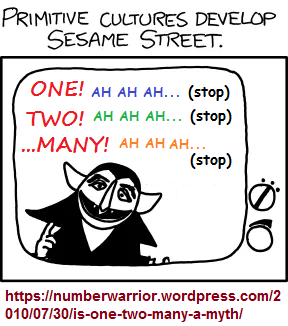 Is "one, two, many" a myth? |
By examining different subjects, in the present case... mathematics, we can observe the usage of a conserved array of basic patterns, reminiscent of the development of a number sense in early humans, and expressed in some cases by those peoples whose life styles are absent a requirement to use additional patterns representing higher quantitative and qualitative ideas. Whereas we may be inclined to say that the pattern-of-three expression of "1-2-many" illustrates an early form of conceptualization, it should not be dismissed that this is a later development after following a one and then two point orientation of thought. Each of which is considered to have had a period in which there was a stop, a choking point, an obstacle in moving on to the next "level" of quantitative conceptualization. Indeed, while we might want to infer that multiple lines or notches on a bone, stone or other material indicates a practice of thinking in a larger progression of enumeration, it may simply be yet another method of pairing. For example, a notch on a bone resembling a one for one correspondence and multiple notices representing some concept related to "many", though the person making multiple notches may not have had an actual word for collectively describing multiple notices. The bone served as the unspoken word related to our present day concept of "many". Nonetheless, despite whether a distinct word existed for "many", the representation of one and multiple notches expressed a pairing of a one and many conceptualization... even if the person engaging in such an activity had any conscious appreciation of this pattern being used.
The medium being used to accommodate the multiple inscriptions of a single line or notch or mark, was representing an as yet concept of one and many. The ability provided by a rock, a bone or cleared off piece of ground to place multiple one by one characters (lines, marks, notches, etc...), was a projection of an underlying cognitive process. Such mediums allowed the human brain to illustrate itself. Yet, when we examine different subjects, the illustration again and again describes a very limited association of using symbols. Hence, we see a recurrence of basic patterns resembling the conceptualizations of early counting efforts. The one, two, three... and sometimes four, five... and a few more at times, gives us an indication that the human brain is using a conserved array of simply patterns that are embellished by compounded words, symbols, gestures, equations, ideas, etc... In other words, the human brain is stuck in a conserved state of expressing itself, despite all the attendant words, signs, symbols and social practices that mask the underlying simplicity. For example, the word "Universe" not only expresses one... or singularity, but the whole, or many, or plurality. In other words, it references the primitive idea of pairing, along with the numerously of 1 and many.
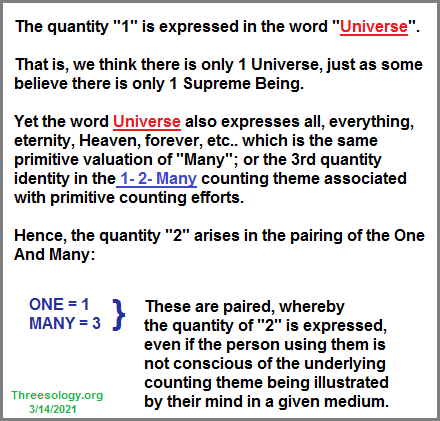
There are multiple words that can be used in place of a number value... and yes, I know you can use other words and provide a link to quantity (more than three) as well. With respect to synonyms, the "MORE" category appears to present us with words that can be interpreted to represent a quantity of two. I have placed some suggestions in parenthesis. Also note that if a person attempts to find synonyms for all the numbers, they are confronted by a serious level of conservation... meaning that only a few numbers have been routinized enough to warrant another (alternative) identity. For example, you may use the word "Pi" and symbol π, for the number 3.14, but try this same sort of undertaking with other numbers, and you won't find any. It is only a handful of numbers... that is, a very strict conservation of numbers which are given a "name" expressed with a word or even symbol. Similar to the genetic code being stuck in using a triplet code, the human brain, as illustrated by the paucity of symbols and references being used in mathematics is also stuck... neither the triplet code nor the evidence of a triplet mental pattern is evolving. This lack of evolution says the human brain is deliberately being forced to be conservative due to the survival requirements we are being faced with due to the incremental deteriorations of the Sun, Earth and Moon.
The "3.14" otherwise known as "pi" and symbolized by "π", is like a person whose family has developed the usage of three names, just as many people have a first, middle and last name. It is a type of mental pattern the human brain engages in for some instances, but not all. In fact, most numbers do not achieve this 3-patterned status of identity.
It can be conjectured that in the very distant past, people were recognized by a single name, however the name was pronounced and whether or not it stood for something that a person was identified with or by. Let us say the first person to get a name was called "ugh" or had an "e" sound to it since this is the customary sound we see being used by children when referring to someone such as altering "Mike" to Mikey, Don to Donnie, Jennifer to Jenniee, Debra to Debbie, etc... (at least in the US they do). As language skills developed and words came into fashionable usage, the "ugh" label was transformed into a more familiar word such as for example "guh" or some equivalent. While this example is made up off the top of my head at this moment in time while writing, the point is that a single word reference was used. We do not know if such references were related to a concept of quantity. However, from the singular word for a name came a binomial naming system which referenced a person's family who may be little more than the singular name associated with the father figure, and a more personalized reference. Later on, a tria nomina Roman naming convention arose, consisting of the combination of praenomen, nomen, and cognomen... known today as a first, middle and last names, though no one-to-one correspondence is being suggested. While some cultures did adopt a multi-name practice in some cases, this has fallen by the wayside in most cases. Conventionally, a person is identified by a single name or a single name with the prefix of Mr. or some professional title, even though the origin of their name may be from a place or activity their ancestors engaged in. However, many people only use two names to reference themselves and not three. Nonetheless, the currency is a representation of an exercise in cognitive conservatism. Dealing with the loss, stability and even gain of a name is a topic which can be entertained by the study of Onomastics or onomatology: is the study of the etymology, history, and use of proper names.
With respect to the current discussion, the aforementioned "3.14" has acquired three names. A number, a word and a symbol. Some numbers may appear to achieve an additional name, but in fact only acquire a reputation such as "666". We don't customarily say reference it with a name such as six-six-six, nor some other symbol... though some person or group of people may do so for their private use. Another example is the word "time". We have no single number that references time, though the face of a clock may be used as a symbol of time. A singular or monomial naming scheme is used. Some do achieve a binomial reference, and others such as "3.14" a trinomial distinction, but most remain singular. You may come across a word which you think describes more than one form of expressed name, but such instances appear to be rare.
We could also exhibit monetary currency as particular numbers having a name, while the cent sign (¢) and dollar sign ($) are the only two used in a generic sense to identify individual denominations as a binary type of expression such a $125.25 ¢s;, though the cent symbol is not included in such instances.
| 1 | 2 | 5 | 10 | 20 | 25 | 50 | 100 |
| one | two | five | ten | twenty | twenty five | fifty | one hundred |
| penny | 2 dollar bill | five cents 5 dollars | ten cents ten dollars | twenty dollars | twenty five cents | fifty cents fifty dollars | One dollar coin one dollar bill |
| synonyms: cent red cent copper penny farthing hill of beans |
No synonyms | nickel buffalo head; five dollar bill; five-spot; fiver |
dime Ten dollar bill: sawbuck; Hamilton, tenner; bill; note; government note; bank bill; banker's bill; bank note; banknote; Federal Reserve note; greenback interglot | Twenty dollars: Jackson | 25 | fifty dollars: pineapple or Big pineapple | 100 dollars: C note |
Student-centered teaching versus Teacher-centered Instruction
| ONE | Universe, single, alone, chosen one, Heaven, Hell, Purgatory, mortality, identity, circumspection, time, space, unicycle... |
| TWO | pairing, dichotomy, duality, couple, identical, androgynous, Janus faced, opposite, bicycle... |
| MANY | Universe, all, much, plenty, heap, infinity, immortality, galaxy, cosmos, time, space, dimension, polynomial, cycles... |
Here are some Synonyms for ONE, Synonyms for TWO , synonyms for MANY, synonyms for MORE:, synonyms for MOST. Different sources may provide you with more or fewer examples, but the following list is functional for the purposes of illustration:
|
|
|
|
|
Page initially created: Wednesday, March 3rd, 2021... 1:19:25 PM
Page initially posted: Saturday, May 22nd, 2021... 7:09 AM
Updated page: Monday, December 6th, 2021... 6:23 AM
Herb O. Buckland
herbobuckland@hotmail.com